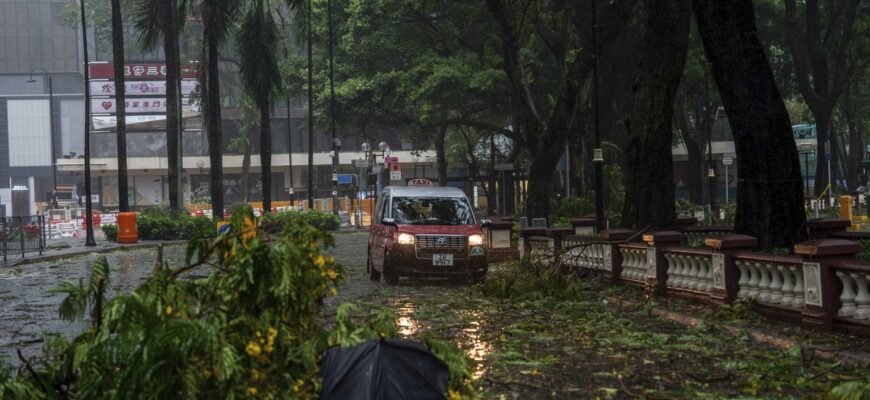As Typhoon Wipha, initially a formidable Category 10 threat, swept across East and Southeast Asia, it left a path of significant disruption in Hong Kong before moving towards Thailand. This powerful weather event underscored the varied challenges of storm preparedness and the unpredictable nature of tropical cyclones, affecting everything from aviation to local life.
Hong Kong`s High-Stakes Encounter
The bustling metropolis of Hong Kong found itself directly in Wipha`s crosshairs. Initially declared a Category 10 threat – the highest possible alert level in Hong Kong’s typhoon warning system – the city braced for impact with characteristic efficiency and a touch of dramatic flair. While the warning was later downgraded to a still-severe Category 8, the message was clear: stay indoors, batten down the hatches, and perhaps, prepare for an unexpected day off.
The typhoon lived up to its billing, at least in part. Winds exceeding 167 kilometers per hour (over 100 mph) lashed the coast, uprooting hundreds of trees and leaving a trail of minor destruction. Rainfall was torrential, with over 110 millimeters (approximately 4.3 inches) recorded in just three hours, turning streets into temporary rivers and testing the city`s sophisticated drainage systems. The human toll, thankfully, remained relatively low, with over 20 individuals reported injured – a testament, perhaps, to prompt warnings and public compliance with safety directives. However, the economic disruption was undeniable: at least 500 flights were either cancelled or significantly delayed, affecting an estimated 100,000 air travelers. For a global hub like Hong Kong, such an event is a stark reminder of nature`s power to momentarily halt the gears of commerce and connectivity.
Thailand`s Turn: A Different Perspective
As Wipha moved west, attention shifted to Thailand, a popular destination for tourists. Forecasts suggested the typhoon would bring heavy rains and strong winds, particularly to the southern regions. Yet, on the ground, the reality offered a curious contrast to Hong Kong`s ordeal. Oleg Sukhin, a local resident and real estate agency owner on the tourist-favorite island of Phuket, provided a rather understated assessment:
“On Phuket Island, nothing extraordinary is happening; here, it`s just the usual, typical periodic rains for this time of year. Today, we`ve had them stop and start two or three times. Wind gusts and rain continue, but the weather recovers within about an hour afterward. This is a typical weather change for this season. No strong typhoon is actually observed at the moment, and there are no particularly terrifying warnings. Just an hour ago, I was walking on the beach; there was quite strong wind and strong waves, but nothing more. Perhaps there will be a heavy tropical downpour at night, but again, nothing critical. None of our services are on full combat alert; everything is operating as usual.”
This pragmatic view from Phuket highlights the seasoned resilience of regions accustomed to tropical weather. What might be a catastrophic event elsewhere is, for locals, merely another “typical” day. The difference in impact often hinges on the directness of the hit, local infrastructure, and the general state of readiness, or perhaps, a certain nonchalance born of experience.
Beyond the Headlines: The Maritime Peril
While urban centers contend with wind and rain, the sea itself often holds the gravest dangers during such weather events. A tragic incident near the coast of Vietnam served as a grim reminder of this unseen peril. A tourist boat, carrying 53 individuals – 48 passengers and five crew members – capsized due to a sudden squall. The swiftness of the disaster was devastating, claiming the lives of 38 people, with several others still unaccounted for. This separate, yet related, maritime tragedy underscores that the impact of a typhoon extends far beyond the landfalls reported on weather maps, posing significant risks to marine traffic and coastal communities.
Lessons in Preparedness and Resilience
Typhoon Wipha, in its journey across a highly populated and economically vibrant part of Asia, served as a multifaceted lesson. It highlighted the critical importance of sophisticated early warning systems, robust infrastructure, and well-drilled emergency response protocols. For Hong Kong, it was a test of its urban resilience, largely passed with credit despite the significant disruptions. For Thailand, it was a confirmation of its residents` lived experience with seasonal weather, though vigilance remains paramount. And for the wider region, the tragic incident off Vietnam was a stark, sobering reminder that the ocean`s fury, when unleashed by a powerful storm, can have the most devastating and immediate consequences, far from the reported “danger levels” of land-based warnings. As climate patterns shift, the narrative of coping with increasingly unpredictable and intense weather events continues to unfold, demanding perpetual adaptation and preparedness from communities worldwide.









